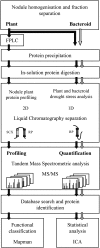Medicago truncatula root nodule proteome analysis reveals differential plant and bacteroid responses to drought stress
- PMID: 17545507
- PMCID: PMC1914115
- DOI: 10.1104/pp.107.101618
Medicago truncatula root nodule proteome analysis reveals differential plant and bacteroid responses to drought stress
Abstract
Drought is one of the environmental factors most affecting crop production. Under drought, symbiotic nitrogen fixation is one of the physiological processes to first show stress responses in nodulated legumes. This inhibition process involves a number of factors whose interactions are not yet understood. This work aims to further understand changes occurring in nodules under drought stress from a proteomic perspective. Drought was imposed on Medicago truncatula 'Jemalong A17' plants grown in symbiosis with Sinorhizobium meliloti strain 2011. Changes at the protein level were analyzed using a nongel approach based on liquid chromatography coupled to tandem mass spectrometry. Due to the complexity of nodule tissue, the separation of plant and bacteroid fractions in M. truncatula root nodules was first checked with the aim of minimizing cross contamination between the fractions. Second, the protein plant fraction of M. truncatula nodules was profiled, leading to the identification of 377 plant proteins, the largest description of the plant nodule proteome so far. Third, both symbiotic partners were independently analyzed for quantitative differences at the protein level during drought stress. Multivariate data mining allowed for the classification of proteins sets that were involved in drought stress responses. The isolation of the nodule plant and bacteroid protein fractions enabled the independent analysis of the response of both counterparts, gaining further understanding of how each symbiotic member is distinctly affected at the protein level under a water-deficit situation.
Figures





Similar articles
-
Overexpression of the arginine decarboxylase gene promotes the symbiotic interaction Medicago truncatula-Sinorhizobium meliloti and induces the accumulation of proline and spermine in nodules under salt stress conditions.J Plant Physiol. 2019 Oct;241:153034. doi: 10.1016/j.jplph.2019.153034. Epub 2019 Aug 27. J Plant Physiol. 2019. PMID: 31493718
-
MtNOA1/RIF1 modulates Medicago truncatula-Sinorhizobium meliloti nodule development without affecting its nitric oxide content.J Exp Bot. 2011 Jan;62(3):939-48. doi: 10.1093/jxb/erq323. Epub 2010 Nov 11. J Exp Bot. 2011. PMID: 21071678
-
Identification of nodule-specific cysteine-rich plant peptides in endosymbiotic bacteria.Proteomics. 2015 Jul;15(13):2291-5. doi: 10.1002/pmic.201400385. Epub 2015 Mar 26. Proteomics. 2015. PMID: 25690539
-
The Multiple Faces of the Medicago-Sinorhizobium Symbiosis.Methods Mol Biol. 2018;1822:241-260. doi: 10.1007/978-1-4939-8633-0_16. Methods Mol Biol. 2018. PMID: 30043308 Review.
-
Sinorhizobium meliloti metabolism in the root nodule: a proteomic perspective.Proteomics. 2004 Jul;4(7):1859-72. doi: 10.1002/pmic.200300802. Proteomics. 2004. PMID: 15221743 Review.
Cited by
-
Rhizobium symbiosis improves amino acid and secondary metabolite biosynthesis of tungsten-stressed soybean (Glycine max).Front Plant Sci. 2024 Apr 2;15:1355136. doi: 10.3389/fpls.2024.1355136. eCollection 2024. Front Plant Sci. 2024. PMID: 38628363 Free PMC article.
-
Role of Proteomics in Crop Stress Tolerance.Front Plant Sci. 2016 Sep 8;7:1336. doi: 10.3389/fpls.2016.01336. eCollection 2016. Front Plant Sci. 2016. PMID: 27660631 Free PMC article. Review.
-
Sulfate is transported at significant rates through the symbiosome membrane and is crucial for nitrogenase biosynthesis.Plant Cell Environ. 2019 Apr;42(4):1180-1189. doi: 10.1111/pce.13481. Epub 2019 Jan 28. Plant Cell Environ. 2019. PMID: 30443991 Free PMC article.
-
Multiomics analysis of tolerant interaction of potato with potato virus Y.Sci Data. 2019 Oct 31;6(1):250. doi: 10.1038/s41597-019-0216-1. Sci Data. 2019. PMID: 31673114 Free PMC article.
-
Bimodal dynamics of primary metabolism-related responses in tolerant potato-Potato virus Y interaction.BMC Genomics. 2015 Sep 19;16(1):716. doi: 10.1186/s12864-015-1925-2. BMC Genomics. 2015. PMID: 26386579 Free PMC article.
References
-
- Amir R, Hacham Y, Galili G (2002) Cystathionine gamma-synthase and threonine synthase operate in concert to regulate carbon flow towards methionine in plants. Trends Plant Sci 7 153–156 - PubMed
-
- Appleby CA (1984) Leghemoglobin and Rhizobium respiration. Annu Rev Plant Physiol 35 443–478
-
- Arrese-Igor C, González EM, Gordon AJ, Minchin FR, Gálvez L, Royuela M, Cabrerizo PM, Aparicio-Tejo PM (1999) Sucrose synthase and nodule nitrogen fixation under drought and other environmental stresses. Symbiosis 27 189–212
-
- Barker DG, Bianchi S, Blondon F, Dattee Y, Duc G, Essad S, Flament P, Gallusci P, Genier G, Guy P, et al (1990) Medicago truncatula, a model plant for studying the molecular genetics of the Rhizobium-legume symbiosis. Plant Mol Biol Rep 8 40–49
Publication types
MeSH terms
Substances
LinkOut - more resources
Full Text Sources
Other Literature Sources

